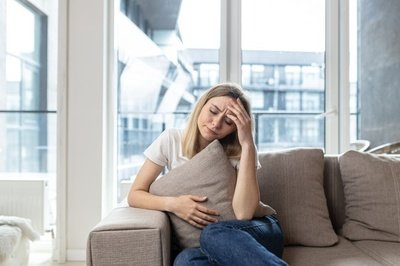Can Women with Dysmenorrhea be Addicted to Painkillers?
Everyone is saying menstrual pain can reach the eighth degree during production. Every month, the physiological pain that strikes the stomach is like a pair of invisible hands turning rivers and seas inside.

Let's know how menstruation is formed. And how is dysmenorrhea going on?
The female internal genitalia is composed of the ovary and fallopian tube. The ovary contains dozens of follicles, and each follicle contains an egg. The egg can only survive for 12-24 hours in the uterus. If the ovulated egg is fertilized, the fertilized egg is transported to the uterus through the fallopian tube and develops into pregnancy. If there is no fertilization, it will lose its activity when the time is up. Two weeks later, it will be discharged together with the endometrium after it falls off. This is called menstruation.
The menstrual cycle is generally 21-35 days, but it varies from person to person, and some people have 40 days or so. As long as there is regularity, it generally belongs to normal menstruation. During menstruation, the uterus will contract. When the amount of menstruation is too large, or the discharge is not smooth, dysmenorrhea can easily occur. In addition, the biggest culprit of dysmenorrhea is the secretion of prostaglandins. Cold, emotional tension, stress, etc., may stimulate uterine contraction to cause dysmenorrhea.
What is dysmenorrhea?
Dysmenorrhea is when menstruation comes, or before and after menstruation, there is severe abdominal pain, which can not be tolerated. It is called dysmenorrhea.
Dysmenorrhea is divided into primary dysmenorrhea and secondary dysmenorrhea. Primary dysmenorrhea accounts for more than 90% of dysmenorrhea, mainly excluding dysmenorrhea caused by organic diseases. That is, there is no other disease except pain. Although dysmenorrhea is not a disease, severe pain will significantly affect life.
You should see a doctor at a time when the following three symptoms are appropriate.
Severe pain is intolerable, accompanied by a pale face and sweating.
Faint to the ground, it was simply a sea-shaking pain.
Nausea, vomiting, dizziness, and other symptoms occur.
Dysmenorrhea is painful. How can women relieve it?
Lie flat. It can relax the body and promote the circulation of blood.
You can use a hot water bag to warm your baby's waist and lower abdomen, which will relieve the pain to a certain extent.
Under the doctor's guidance, take some painkillers (ibuprofen) or short-acting contraceptives. Contraceptives can effectively reduce the synthesis of prostaglandins and have a specific effect on endometriosis and adenomyosis. When endometriosis and adenomyosis are diagnosed, patients can also choose to take Fuyan Pill for treatment.
Eat more warm food, drink some brown sugar water to warm the uterus and stomach, expel cold and dehumidify, promote blood circulation, and remove blood stasis.
It is especially suitable for girls afraid of cold in the palace.
Can women with dysmenorrhea be addicted to painkillers?
Pain is often spasmodically concentrated in the lower abdomen, sometimes with headache, fatigue, dizziness, nausea, vomiting, diarrhea, waist and leg pain, and other symptoms. The treatment focuses on pain relief, mainly using nonsteroidal anti-inflammatory drugs, such as acetaminophen, ibuprofen, and indomethacin. These drugs can inhibit the production of peripheral prostaglandins, reduce the release of pain-causing factors, and thus effectively relieve pain. Some people worry that they will become addicted to painkillers.
There is no need to worry. People often call addiction drug addiction in medicine. Common addictive drugs mainly refer to opioids. These drugs act on the brain's pain center, producing central analgesic effects and even new pleasure, which leads to physical and psychological dependence, ultimately leading to drug withdrawal.
The action site and mechanism of drugs for dysmenorrhea differ from those for dysmenorrhea. Therefore, oral nonsteroidal analgesics can effectively relieve pain without causing addiction.
You may also be interested in:
Why do So Many People Regret Doing Surgery to Treat Adenomyosis?
previous pageAdenomyosis: Patients with Different Symptoms and Ages Need Different Treatments
next page
You may also be interested in
- What Are the Natural Herbal Remedies for Relieving Dysmenorrhea?
- Long-term Dysmenorrhea from Adenomyosis: These 2 Exercises Can Help
- Have You Ever Thought That Your Dysmenorrhea May Be Caused by Pelvic Inflammatory Disease(PID)?
- Can Primary Dysmenorrhea Progress to Adenomyosis?
- Is Moxibustion Therapy Effective In Relieving Menstrual Cramps? What Should You Pay Attention To?
Testimonials
- Adenomyosis with Ureaplasma Urealyticum Cured by Fuyan Pill
- Tubal blockage with hydrosalpinx can be cured by TCM shortly
- Fuyan Pill Helps A woman with Adenomyosis Get Pregnant
- A Woman with Hydrosalpinx Is Cured with Fuyan pill
- Pelvic Inflammatory Disease Testimonials
- Irregular Vaginal Bleeding and Endometrial Thickening Cured by Fuyan Pill
- Pruritus Vulvae and Frequent Urination: Mycoplasma Infection Cured after 2 Courses



